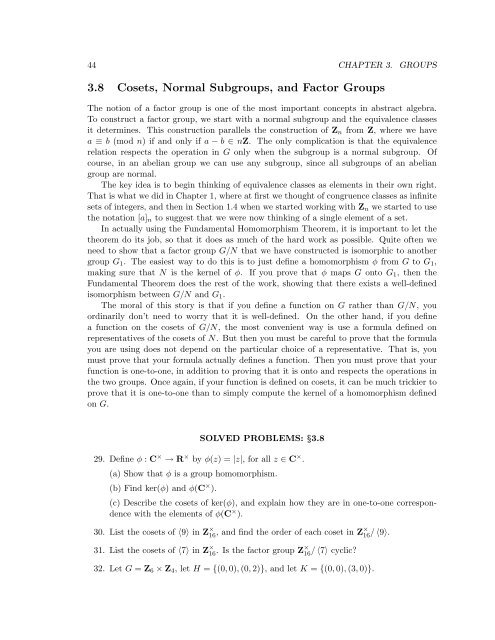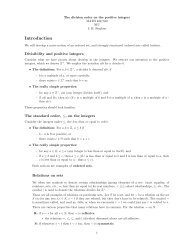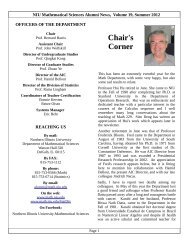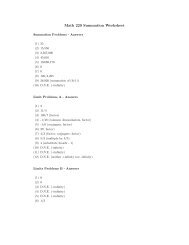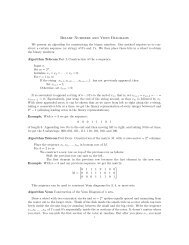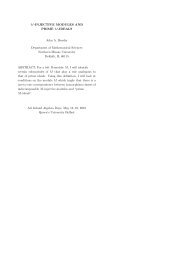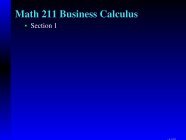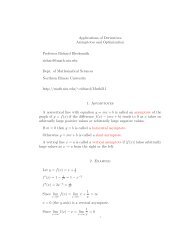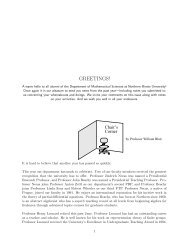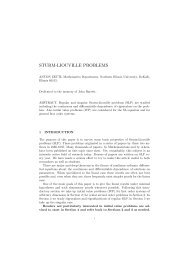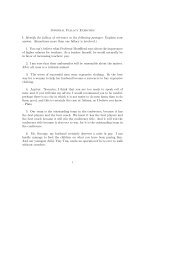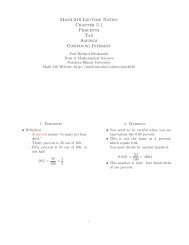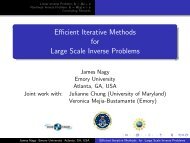abstract algebra: a study guide for beginners - Northern Illinois ...
abstract algebra: a study guide for beginners - Northern Illinois ...
abstract algebra: a study guide for beginners - Northern Illinois ...
You also want an ePaper? Increase the reach of your titles
YUMPU automatically turns print PDFs into web optimized ePapers that Google loves.
44 CHAPTER 3. GROUPS<br />
3.8 Cosets, Normal Subgroups, and Factor Groups<br />
The notion of a factor group is one of the most important concepts in <strong>abstract</strong> <strong>algebra</strong>.<br />
To construct a factor group, we start with a normal subgroup and the equivalence classes<br />
it determines. This construction parallels the construction of Zn from Z, where we have<br />
a ≡ b (mod n) if and only if a − b ∈ nZ. The only complication is that the equivalence<br />
relation respects the operation in G only when the subgroup is a normal subgroup. Of<br />
course, in an abelian group we can use any subgroup, since all subgroups of an abelian<br />
group are normal.<br />
The key idea is to begin thinking of equivalence classes as elements in their own right.<br />
That is what we did in Chapter 1, where at first we thought of congruence classes as infinite<br />
sets of integers, and then in Section 1.4 when we started working with Zn we started to use<br />
the notation [a]n to suggest that we were now thinking of a single element of a set.<br />
In actually using the Fundamental Homomorphism Theorem, it is important to let the<br />
theorem do its job, so that it does as much of the hard work as possible. Quite often we<br />
need to show that a factor group G/N that we have constructed is isomorphic to another<br />
group G1. The easiest way to do this is to just define a homomorphism φ from G to G1,<br />
making sure that N is the kernel of φ. If you prove that φ maps G onto G1, then the<br />
Fundamental Theorem does the rest of the work, showing that there exists a well-defined<br />
isomorphism between G/N and G1.<br />
The moral of this story is that if you define a function on G rather than G/N, you<br />
ordinarily don’t need to worry that it is well-defined. On the other hand, if you define<br />
a function on the cosets of G/N, the most convenient way is use a <strong>for</strong>mula defined on<br />
representatives of the cosets of N. But then you must be careful to prove that the <strong>for</strong>mula<br />
you are using does not depend on the particular choice of a representative. That is, you<br />
must prove that your <strong>for</strong>mula actually defines a function. Then you must prove that your<br />
function is one-to-one, in addition to proving that it is onto and respects the operations in<br />
the two groups. Once again, if your function is defined on cosets, it can be much trickier to<br />
prove that it is one-to-one than to simply compute the kernel of a homomorphism defined<br />
on G.<br />
SOLVED PROBLEMS: §3.8<br />
29. Define φ : C × → R × by φ(z) = |z|, <strong>for</strong> all z ∈ C × .<br />
(a) Show that φ is a group homomorphism.<br />
(b) Find ker(φ) and φ(C × ).<br />
(c) Describe the cosets of ker(φ), and explain how they are in one-to-one correspondence<br />
with the elements of φ(C × ).<br />
30. List the cosets of 〈9〉 in Z × 16 , and find the order of each coset in Z× 16 / 〈9〉.<br />
31. List the cosets of 〈7〉 in Z × 16 . Is the factor group Z× 16 / 〈7〉 cyclic?<br />
32. Let G = Z6 × Z4, let H = {(0, 0), (0, 2)}, and let K = {(0, 0), (3, 0)}.


